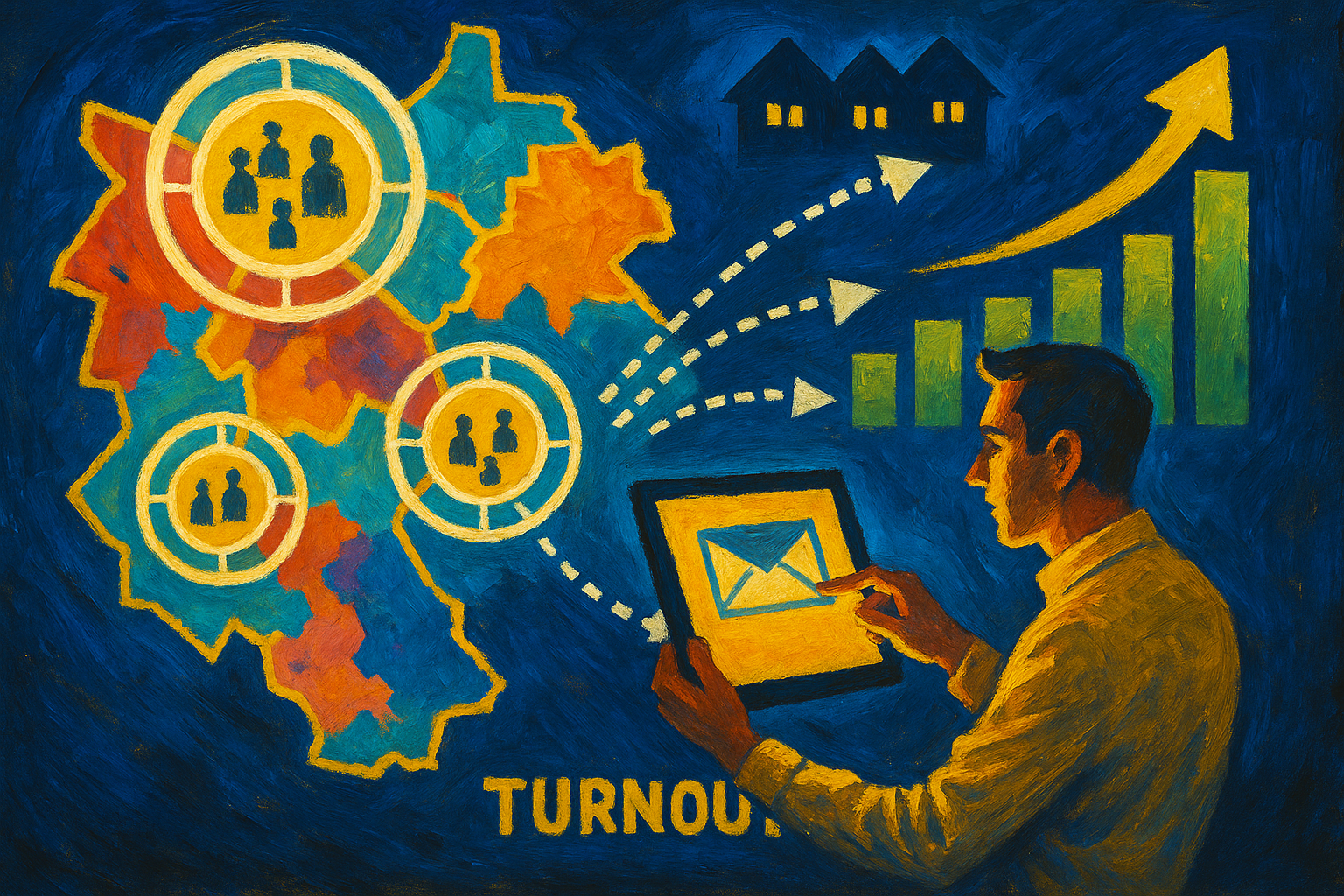Boost Turnout with Data-Driven Voter Segmentation
The Power of Data-Driven Voter Segmentation in Elections
Today’s elections aren’t won by reaching everyone. They’re won by reaching the right voters, with the right message, at the right time. If you want to maximize turnout and give your campaign a winning edge, you need to boost turnout with data-driven voter segmentation. This isn’t just a buzzword—it’s the secret weapon behind record-breaking turnout, higher engagement, and more efficient campaigns at every level.
In this guide, you’ll learn exactly what voter segmentation is, why it matters, and how you can use it to energize your supporters and win more elections.

What Is Data-Driven Voter Segmentation?
At its core, data-driven voter segmentation means dividing your potential voters into specific groups—segments—based on key factors like demographics, geography, behavior, or interests. Instead of sending the same message to everyone, you tailor your outreach to what matters most to each group.
But what makes it “data-driven”? Rather than guessing who your key voters are, you use actual analytics and up-to-date data to create these segments. Sources include official voter files, U.S. Census data, turnout history, party registration, and even surveys on issue preferences. Campaigns layer in digital behavior, language preferences, and location information for even more precision.
Leading political data experts and organizations like the National Conference of State Legislatures (NCSL) and the U.S. Election Assistance Commission (EAC) endorse segmentation as one of the most effective ways to engage voters and improve turnout. As Dr. Samuel Ortiz, a top data strategist for national campaigns, explains: “Segmentation lets campaigns do more than just talk at voters—it lets them start real conversations, build trust, and move people to action.”
Why Segmentation Matters for Voter Turnout
The days of blanketing a district with generic mailers or robocalls are over. Personalized communication gets results. When you segment your voter universe and craft messages for each group, your campaign becomes more relevant, more persuasive, and more efficient.
Studies show that segmented voter outreach produces turnout rates up to 15% higher than non-segmented campaigns. According to EAC voter engagement research, personalized messages—delivered by mail, text, or door-to-door—are twice as likely to motivate a response as generic appeals. Voters are more likely to trust a campaign that understands their needs, speaks their language, and recognizes their concerns.
Segmentation also helps campaigns use resources more wisely. Instead of wasting time and money contacting unlikely voters, you focus on those who can make the biggest difference—like swing voters, new registrants, or low-propensity groups who might need an extra nudge. By narrowing your universe and concentrating your outreach, every dollar and every volunteer hour goes further.
Key Data Points for Effective Voter Segmentation
So, what kinds of data make segmentation work? The most effective voter segments are built using a mix of:
Demographics: Age, gender, ethnicity, family status
Geography: District, precinct, zip code, neighborhood
Behavior: Past turnout (always, sometimes, new voters), voting method preference (absentee, early, in-person)
Party Registration: Democrat, Republican, Independent, other
Language: Preferred language for communication
Issue Affinity: Top issues based on surveys, digital behavior, or prior petition signatures
Most campaigns start with the official voter file, then layer on census data, commercial analytics, and results from past campaigns or surveys. Data hygiene—removing duplicates, updating addresses, and cleaning out invalid entries—is critical for accuracy.
Building a Segmentation Strategy
Ready to boost turnout with data-driven voter segmentation? Here’s how to build your strategy:
1. Set Clear Turnout Goals:
Know what you need—how many votes, from which neighborhoods, and which types of voters will make the difference. Identify your priority groups, such as new voters, swing voters, or low-propensity supporters.
2. Choose the Right Tools and Vendors:
Consider platforms like TargetSmart, L2 Political, or VAN, which offer robust voter data, segmentation features, and integration with mail, digital, and field outreach.
3. Segment Your Voters:
Group voters based on the data points most relevant to your campaign. For example, create separate lists for young first-time voters, Spanish-speaking neighborhoods, or seniors who prefer absentee voting.
4. Tailor Your Outreach:
Craft messages for each segment. Use bilingual mailers for language minorities, digital ads for younger voters, or personalized letters for swing households.
5. Integrate with All Channels:
Use segmentation to power every part of your outreach—mail, text, email, door-knocking, and phone banking. Many platforms let you sync segments across channels for seamless targeting.
Overcoming Common Pitfalls
Even experienced campaigns can run into trouble with voter segmentation. Here’s how to avoid the most common mistakes:
Using Old Data: Outdated records can mean wasted mail, missed voters, or embarrassing errors. Always start with the latest voter file and clean your data regularly.
Not Updating Segments: Populations move, demographics shift, and priorities change. Update your segments at least monthly during an active campaign.
Ignoring Data Privacy: Voter data is sensitive. Follow state and federal privacy laws, keep data encrypted, and train staff on secure handling.
Both the CISA and EAC offer strong guidance on protecting voter data, including regular audits, access controls, and secure cloud storage.
Tools and Platforms for Data-Driven Segmentation
Selecting the right data platform is critical. Top-rated tools include:
TargetSmart: Known for deep voter files and micro-targeting options.
L2 Political: Offers geographic and demographic overlays, easy segment creation.
VAN (Voter Activation Network): Integrates with canvassing, mail, and digital tools for holistic campaigns.
Custom Dashboards: For campaigns with technical resources, custom-built dashboards allow real-time analysis and segment updates.
When evaluating platforms, look for:
Ease of use for your team
State compliance and regular data updates
Integration with your outreach (mail, text, digital)
Robust data privacy and security features
For compliance tips, see our Petition Compliance guide.
Final Thoughts
Winning today means going beyond one-size-fits-all outreach. Data-driven voter segmentation is the new gold standard for boosting turnout, building real relationships, and getting every vote that matters. With the right data, the right platform, and the right message, your campaign can energize supporters, persuade swing voters, and win close races.
Don’t leave your turnout to chance.
Contact Sutton & Smart for a data-driven segmentation strategy session and unlock the full power of targeted voter engagement for your next campaign.

Jon Sutton
An expert in management, strategy, and field organizing, Jon has been a frequent commentator in national publications.
Author | Partner





